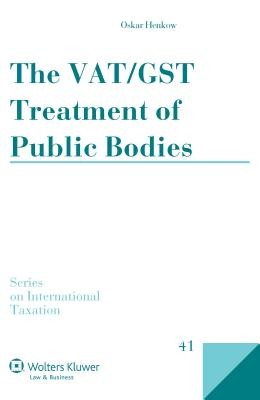
- We will send in 10–14 business days.
- Author: Oskar Henkow
- Publisher: Kluwer Law International
- Year: 2013
- Pages: 230
- ISBN-10: 9041146636
- ISBN-13: 9789041146632
- Format: 15.6 x 23.4 x 1.4 cm, hardcover
- Language: English
- SAVE -10% with code: EXTRA
Reviews
Description
Most VAT systems exclude public bodies from the scope of value added tax (VAT) systems. However, a movement to include public sector bodies within the GST system to some extent or even fully (as in New Zealand) is gaining momentum, and underlies the European Commission's 2011 study on the treatment and economic impact of exemptions in the public interest. Whether the present EU treatment really is as bad as some of its critics suggest, and whether the New Zealand model really is so perfect that jurisdictions with exclusion models ought simply to replace these existing systems with a New Zealand style system: these are the questions which triggered this research and which form the basis for the critical analysis contained in this book. Using a system design point of view, the author focuses on VAT systems where exclusion or inclusion of public bodies are currently being applied and on how these models function. He presents an in-depth analysis of the major issues in this context, such as the treatment of public bodies as taxable persons, their right to deduct input VAT on acquisitions, and the treatment of the income of public bodies. Specific aspects examined [nclude the following: reallocation of funds and income vs. the production/distribution/consumption cycle; the concept of 'merit goods'; bias to self-supply instead of contracting out; preference to integrate vertically in the supply chain; applicability of VAT to government regulatory services; tax cascading in the public goods and services context; administration and compliance burden in government agencies; interpretational and implementation difficulties in EU Member States; and VAT compensation schemes in the public sector context, and whether these constitute illegal State aid. The book concludes with an insightful discussion of what might be considered as 'best practice' in relation to both the exclusion and full tax models. Beyond its thorough discussion of the treatment of public bodies in various VAT systems, and in the EU VAT system in particular, this is the first book on how a GST/VAT system may be designed to best accommodate public bodies, and as such it is sure to be warmly welcomed by practitioners, academics, and policymakers as a valuable contribution to the debate on the relation between VAT and public sector activities.
EXTRA 10 % discount with code: EXTRA
The promotion ends in 18d.03:06:02
The discount code is valid when purchasing from 10 €. Discounts do not stack.
- Author: Oskar Henkow
- Publisher: Kluwer Law International
- Year: 2013
- Pages: 230
- ISBN-10: 9041146636
- ISBN-13: 9789041146632
- Format: 15.6 x 23.4 x 1.4 cm, hardcover
- Language: English English
Most VAT systems exclude public bodies from the scope of value added tax (VAT) systems. However, a movement to include public sector bodies within the GST system to some extent or even fully (as in New Zealand) is gaining momentum, and underlies the European Commission's 2011 study on the treatment and economic impact of exemptions in the public interest. Whether the present EU treatment really is as bad as some of its critics suggest, and whether the New Zealand model really is so perfect that jurisdictions with exclusion models ought simply to replace these existing systems with a New Zealand style system: these are the questions which triggered this research and which form the basis for the critical analysis contained in this book. Using a system design point of view, the author focuses on VAT systems where exclusion or inclusion of public bodies are currently being applied and on how these models function. He presents an in-depth analysis of the major issues in this context, such as the treatment of public bodies as taxable persons, their right to deduct input VAT on acquisitions, and the treatment of the income of public bodies. Specific aspects examined [nclude the following: reallocation of funds and income vs. the production/distribution/consumption cycle; the concept of 'merit goods'; bias to self-supply instead of contracting out; preference to integrate vertically in the supply chain; applicability of VAT to government regulatory services; tax cascading in the public goods and services context; administration and compliance burden in government agencies; interpretational and implementation difficulties in EU Member States; and VAT compensation schemes in the public sector context, and whether these constitute illegal State aid. The book concludes with an insightful discussion of what might be considered as 'best practice' in relation to both the exclusion and full tax models. Beyond its thorough discussion of the treatment of public bodies in various VAT systems, and in the EU VAT system in particular, this is the first book on how a GST/VAT system may be designed to best accommodate public bodies, and as such it is sure to be warmly welcomed by practitioners, academics, and policymakers as a valuable contribution to the debate on the relation between VAT and public sector activities.


Reviews